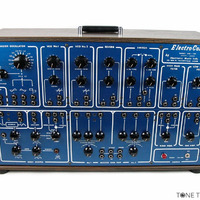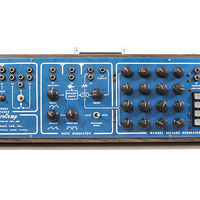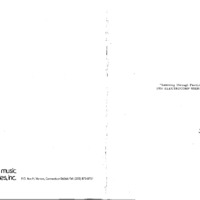EML ElectroComp 200
Item
Model
EML ElectroComp 200
Make
Electronic Music Laboratories
Type
Analog Modular Synth
Description
Made: 1969-1980
Type: Analog Modular
Oscillators: 3
Filters: 2
Sequencers: 0
VCAs: 1
Envelopes: 2
Historical Overview
The Electronic Music Laboratories ElectroComp 200 is a modular analog synth made from 1969 to 1980. Coming out alongside contemporaries such as Moog, Buchla, and ARP, the ElectroComp 200 was one of EML’s first synths and was mainly marketed to educational institutions for its’ ease of use. While capable of making sounds all on its own, TIMARA has the addition of a ElectroComp 300 controller module that sits in front of it, which features additional control interfaces of large routing switches and a 4x4 keypad of buttons with preset voltages. Due to its relative obscurity in its original production, the ElectroComp is now a very rare and valuable synth. While not as popular as other synths of the time, the ElectroComp is capable of a wide variety of sonic material that shouldn’t be passed up.
Principles for Patching
The ElectroComp uses ¼” jacks and cables for routing connections. Similar to a synth like the ARP or the VSC3, it is broken up into separate areas on the front that are clearly labelled. Input and output jacks have numbers assigned to them, as well as arrows that point to what the function of the jack is. Paying attention to the arrows can help understand where certain signals are going or need to go, which is crucial to getting sounds out of the synth. Similar to the Buchla, most audio outputs have at least one multiple so you can send the same signal out to multiple places. A very important thing to note as well is that unlike other synths at the time that featured heavy amounts of voltage control over parameters, the ElectroComp features almost none. The only actual voltage controllable parameters on the device are for the frequency modulation of the VCO’s. Generally the synth is most effective in its ability to route and process audio sources. This is important to understand, as it is a different approach to synth architecture but also a simpler one. By removing extensive amounts of control voltage, you focus much more on the raw sounds that the machine can create and how to process them.
Type: Analog Modular
Oscillators: 3
Filters: 2
Sequencers: 0
VCAs: 1
Envelopes: 2
Historical Overview
The Electronic Music Laboratories ElectroComp 200 is a modular analog synth made from 1969 to 1980. Coming out alongside contemporaries such as Moog, Buchla, and ARP, the ElectroComp 200 was one of EML’s first synths and was mainly marketed to educational institutions for its’ ease of use. While capable of making sounds all on its own, TIMARA has the addition of a ElectroComp 300 controller module that sits in front of it, which features additional control interfaces of large routing switches and a 4x4 keypad of buttons with preset voltages. Due to its relative obscurity in its original production, the ElectroComp is now a very rare and valuable synth. While not as popular as other synths of the time, the ElectroComp is capable of a wide variety of sonic material that shouldn’t be passed up.
Principles for Patching
The ElectroComp uses ¼” jacks and cables for routing connections. Similar to a synth like the ARP or the VSC3, it is broken up into separate areas on the front that are clearly labelled. Input and output jacks have numbers assigned to them, as well as arrows that point to what the function of the jack is. Paying attention to the arrows can help understand where certain signals are going or need to go, which is crucial to getting sounds out of the synth. Similar to the Buchla, most audio outputs have at least one multiple so you can send the same signal out to multiple places. A very important thing to note as well is that unlike other synths at the time that featured heavy amounts of voltage control over parameters, the ElectroComp features almost none. The only actual voltage controllable parameters on the device are for the frequency modulation of the VCO’s. Generally the synth is most effective in its ability to route and process audio sources. This is important to understand, as it is a different approach to synth architecture but also a simpler one. By removing extensive amounts of control voltage, you focus much more on the raw sounds that the machine can create and how to process them.
Access
Those who have permission to use Studio 4
Location
Studio 4 Synth Table



